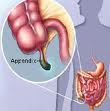Why Can It Be Difficult To Diagnose Appendicitis?
 It can be difficult to diagnose appendicitis. The position of the appendix in the abdomen may vary. Most of the time the appendix is in the right lower abdomen, but the appendix, like other parts of the intestine, has a mesentery. This mesentery is a sheet-like membrane that attaches the appendix to other structures within the abdomen. If the mesentery is large, it allows the appendix to move around. In addition, the appendix may be longer than normal. The combination of a large mesentery and a long appendix allows the appendix to dip down into the pelvis (among the pelvic organs in women). It also may allow the appendix to move behind the colon (called a retro-colic appendix). In either case, inflammation of the appendix may act more like the inflammation of other organs, for example, a woman's pelvic organs.
It can be difficult to diagnose appendicitis. The position of the appendix in the abdomen may vary. Most of the time the appendix is in the right lower abdomen, but the appendix, like other parts of the intestine, has a mesentery. This mesentery is a sheet-like membrane that attaches the appendix to other structures within the abdomen. If the mesentery is large, it allows the appendix to move around. In addition, the appendix may be longer than normal. The combination of a large mesentery and a long appendix allows the appendix to dip down into the pelvis (among the pelvic organs in women). It also may allow the appendix to move behind the colon (called a retro-colic appendix). In either case, inflammation of the appendix may act more like the inflammation of other organs, for example, a woman's pelvic organs.The diagnosis of appendicitis also can be difficult because other inflammatory problems may mimic appendicitis. Therefore, it is common to observe patients with suspected appendicitis for a period of time to see if the problem will resolve on its own or develop characteristics that more strongly suggest appendicitis or, perhaps, another condition.










